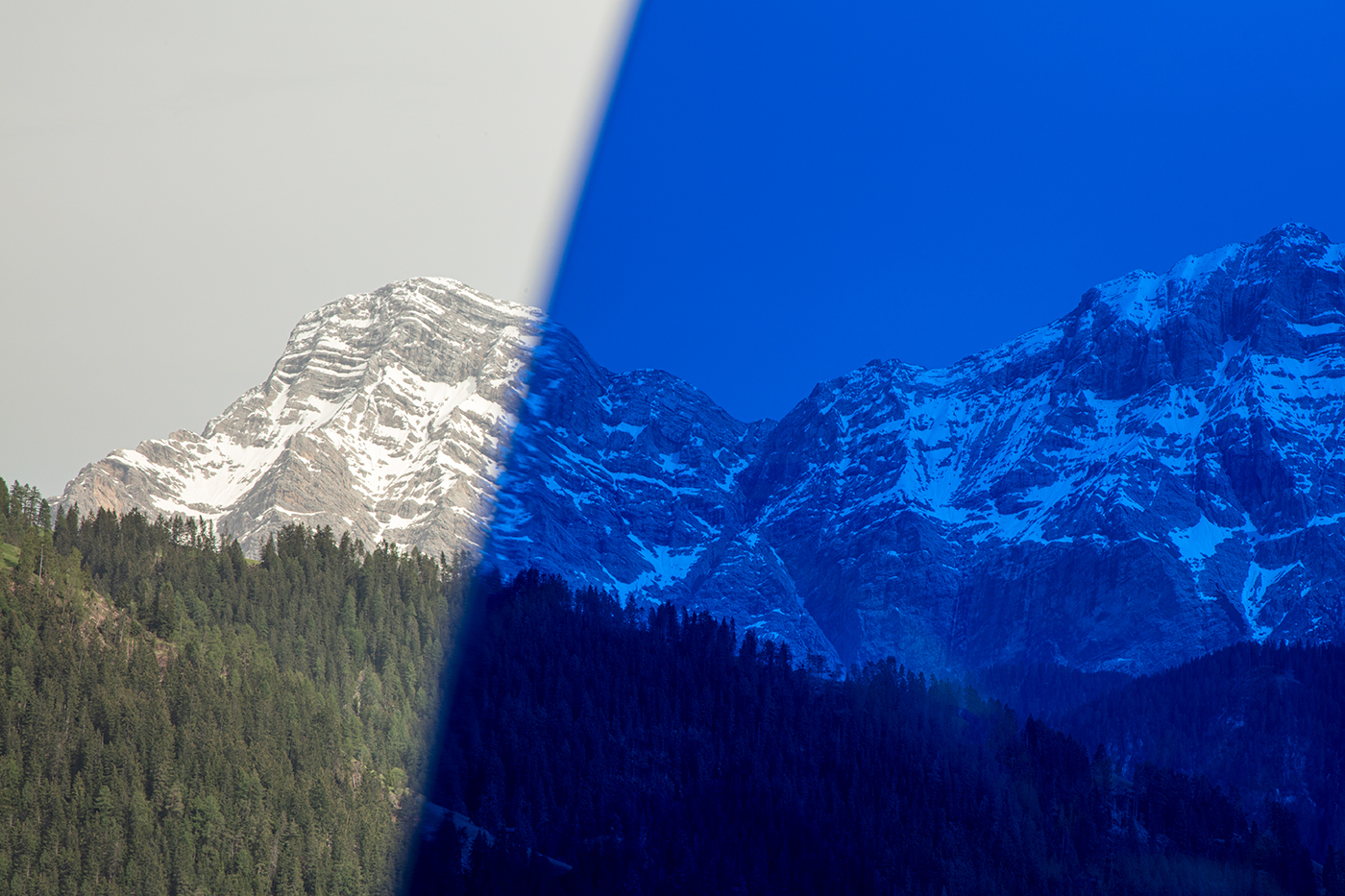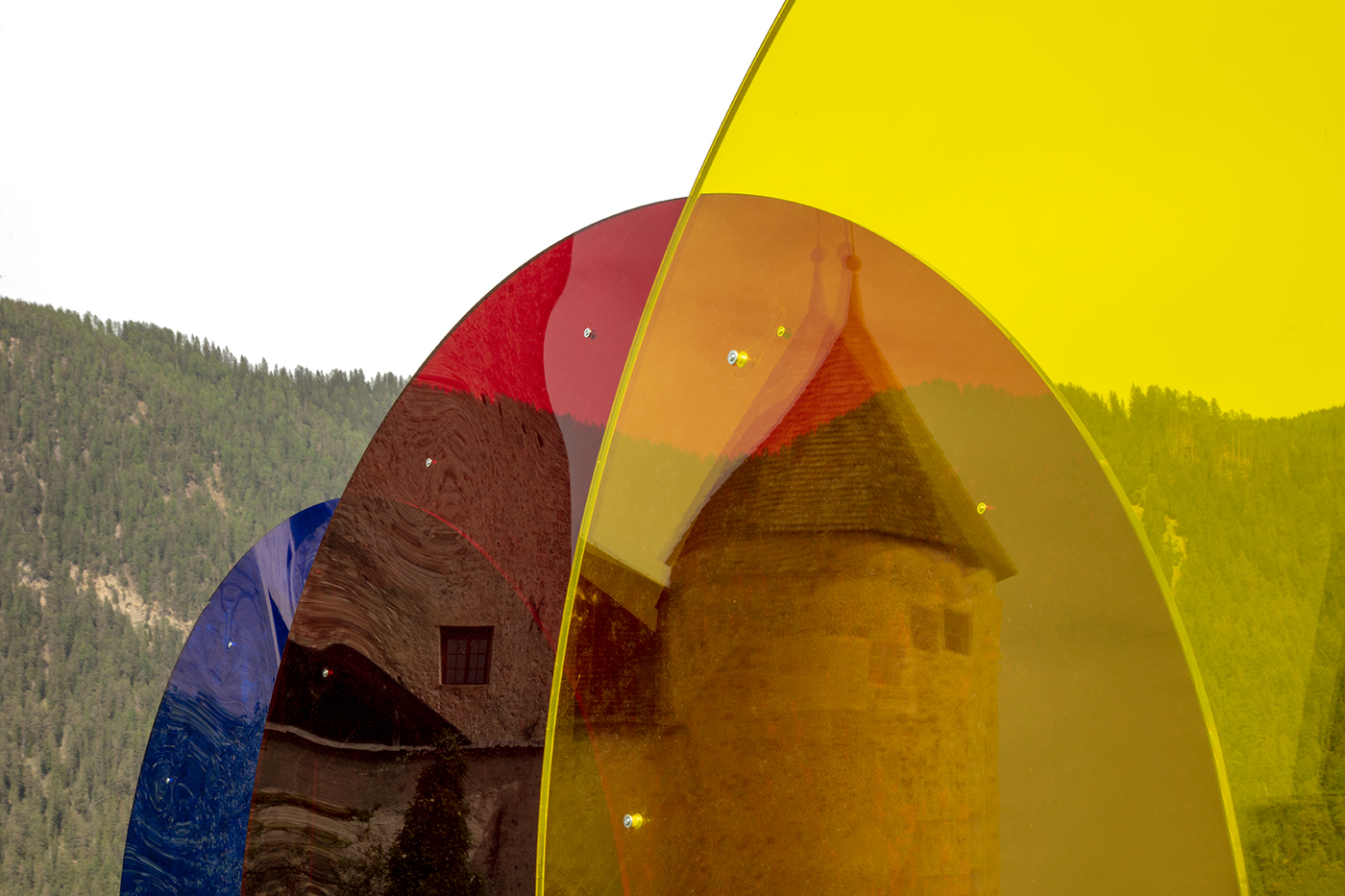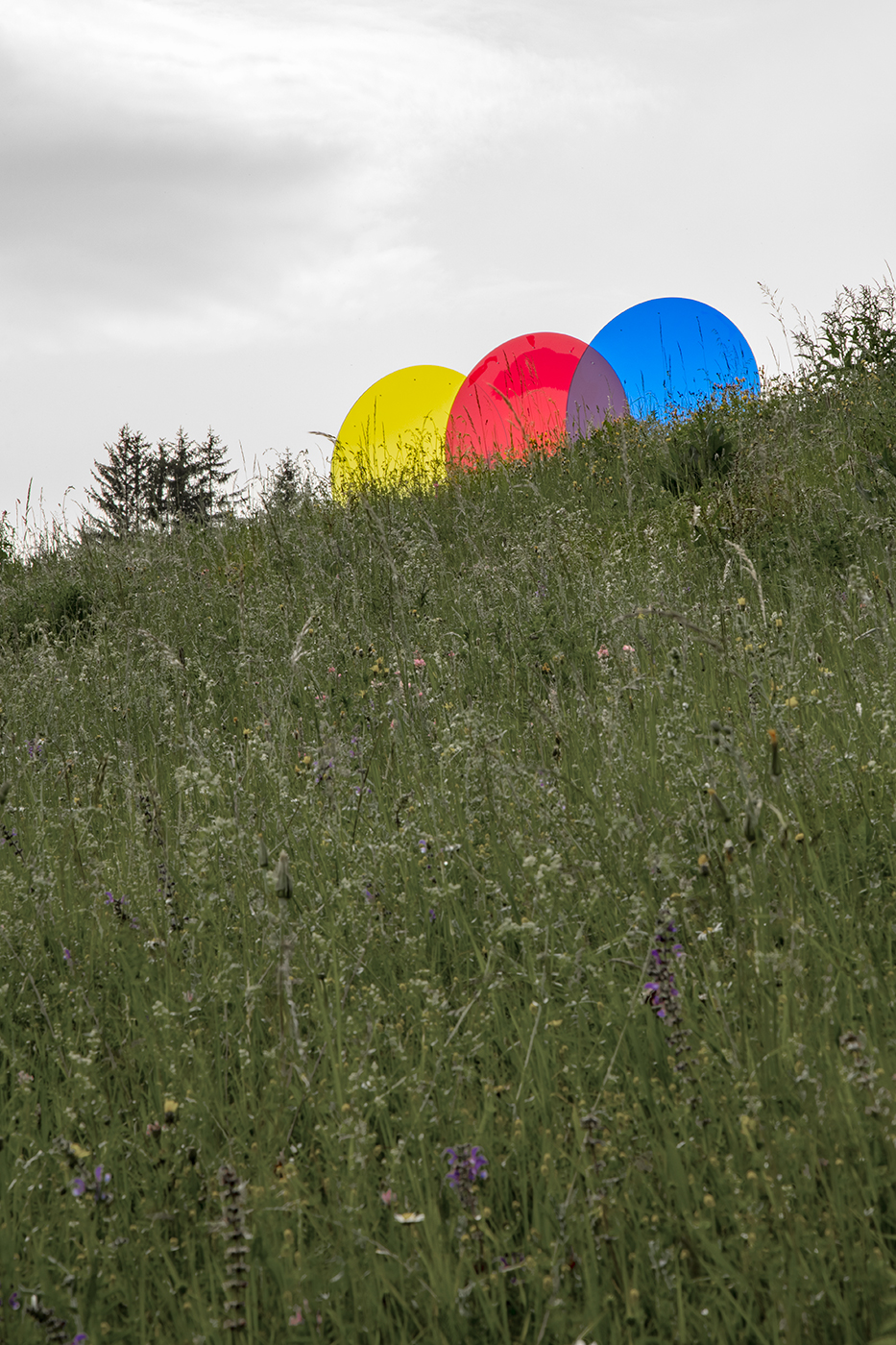ALEMEH & SHAHED MOHAMMADZADEH, “THE SUN”
Rasht, Iran.
Location Ciastel de Tor, San Martin.
Three monochromatic circles of three different colours - blue, red and yellow, i.e. three primary colours, are placed in succession on an oblique line. In Persian Mazdeism, the sphere of the sun is the window through which the divine light radiates the world. More generally, the sun indicates joy and life force. The decision to split the white light of the sun into its three chromatic components also has a symbolic intention that evokes the various triads possible (birth/life/death, intellect/body/soul, past/present/future, and many others). But the triadic symbology is at the same time synthesised in the perfect form of the circle, which in turn expresses perfection, infinity and immortality. Heimat then as a forest of symbols to juggle.
〉 Ladin
Trëi cërtli monocromatics, de trëi corusc desvalis. Bröm, cöce y ghel, trëi corusc primars. Ai é metüs sö unindolater sön na linia desbiech. Tl Mazdeismo persian é la sfera dl sorëdl la finestra tres chëra che la löm divina slomina söl monn. Plü en general é le sorëdl n simbol de ligrëza y forza vitala. Iadô la dezijiun da despartí la löm blancia dl sorëdl te sües trëi componëntes cromatiches él ince l’intenziun simbolica da evoché de vingi sort de triades poscibles (nasciöda/vita/mort, intelët/corp/anima, passé/presënt/dagní, y tröpes d’atres). Mo la simbologia triadica vëgn tl medemo tëmp sintetisada tla forma perfeta dl cërtl, espresciun dla perfeziun, dl infiní y dl’imortalité. Heimat sciöche n bosch de simboi da passé amesafora.
〉 Italiano
Tre cerchi monocromatici, di tre colori diversi, blu, rosso e giallo, ovvero tre colori primari, sono posti in successione su una linea obliqua. Nel Mazdeismo persiano la sfera del sole è la finestra attraverso la quale la luce divina irradia il mondo. Più generalmente il sole sta ad indicare gioia e forza vitale. La decisione di scindere la luce bianca del sole nelle sue tre componenti cromatiche ha pure un’intenzione simbolica che evoca le svariate triadi possibili (nascita/vita/morte, intelletto/corpo/anima, passato/presente/futuro, e tante altre). Ma la simbologia triadica è allo stesso tempo sintetizzata nella forma perfetta del cerchio, che a sua volta esprime perfezione, infinito e immortalità. Heimat quindi come foresta di simboli tra i quali destreggiarsi.
〉 Deutsch
Drei einfarbige Kreise in drei verschiedenen Farben: Blau, Rot und Gelb, d.h. drei Grundfarben, sind nebeneinander auf einer gewölbten Linie angeordnet. Im persischen Zoroastrismus ist die Sonnenkugel das Fenster, durch das das göttliche Licht die Welt anstrahlt. Generell steht die Sonne für Freude und Lebenskraft. Der Entscheidung, das weiße Licht der Sonne in seine drei Farbkomponenten aufzuspalten, liegt auch eine symbolische Absicht zugrunde, die an verschiedene mögliche Triaden denken lassen will (Geburt / Leben / Tod; Intellekt / Körper / Seele; Vergangenheit / Gegenwart / Zukunft und viele andere mehr). Zudem wird die triadische Symbolik gleichzeitig in der vollendeten Form des Kreises synthetisiert, der wiederum Perfektion, Unendlichkeit und Unsterblichkeit ausdrückt. Heimat also als ein Wald von Symbolen, zwischen denen es sich durchzuschlängeln gilt.
EXHIBIT SPACE
The Ćiastel de Tor, San Martin - Studies have dated San Martin de Tor back to Roman times. A number of paths and locations found in what is now the town centre can be traced back to the practice of subdividing land into quadrilateral lots, which was typical of the era. Also, it is believed that the word "quadra" (square in Italian), which was initially used as a term for a surface, was extended to the whole of the Badia valley (Gadertal in German). It was only later that the term "Gader" originally "Kaidra" – “Square”. was introduced. Today, the castle, which dates from the early 13th century, houses the "Museum Ladin".
〉 Ladin
Le Ćiastel de Tor, San Martin - Aladô de stüdi dess avëi le paîsc da San Martin de Tor söes raîsc ti tëmps romans. Tòć de trus y termi a süd dla Dlijia al dedaincö po gnì passenà a n moto cuadrat de mosoraziun romana. La nominaziun "quadra" por chësta sort de spartiziun dl terac dess ester gnüda anuzada tl pröm ma por na spersa, spo plü tert por döta la Val Badia; la parora atuala "Gader", laôta "Kaidra", dess gnì da en insediamënt fat sö aladô de n moto roman. Tl ćiastel d’al dedaincö che va zoruch te val’ pert ai pröms agn dl 13ejim seco, él lascè jö le Museum Ladin.
〉 Italiano
l Ćiastel de Tor, San Martino - La località di San Martino in Badia ha avuto origine durante l’epoca romana. Infatti, se si presta attenzione alla posizione di vari sentieri e di alcuni punti che si trovano a sud della chiesa, questi possono essere ricondotti ad una suddivisione del terreno a forma di quadrilatero che era tipica dell’epoca. Si pensa infatti che il termine „quadra”, impiegato inizialmente per nominare una superficie, si sia esteso poi all’intera Val Badia, che in tedesco prende il nome di Gadertal. Il termine „Gader“ derivante da „Kaidra“. Oggi, nel castello che risale ai primi anni del XIII secolo, si può visitare il Museum Ladin.
〉 Deutsch
Der Ćiastel de Tor, St. Martin - Der Ursprung des Ortes Sankt Martin kann bis auf die Römerzeit zurückgeführt werden. Einzelne Wege und Markierungen südlich der Dorfkirche weisen auf das römische Quadratmuster hin. Von einer nach römischen Muster dort angelegten Siedlung komme der heutige Name „Gader“, früher „Kaidra“. Im Schloss von St. Martin in Thurn, welches im 13. Jh erbaut wurde, befindet sich heute das Ladinische Museum.



